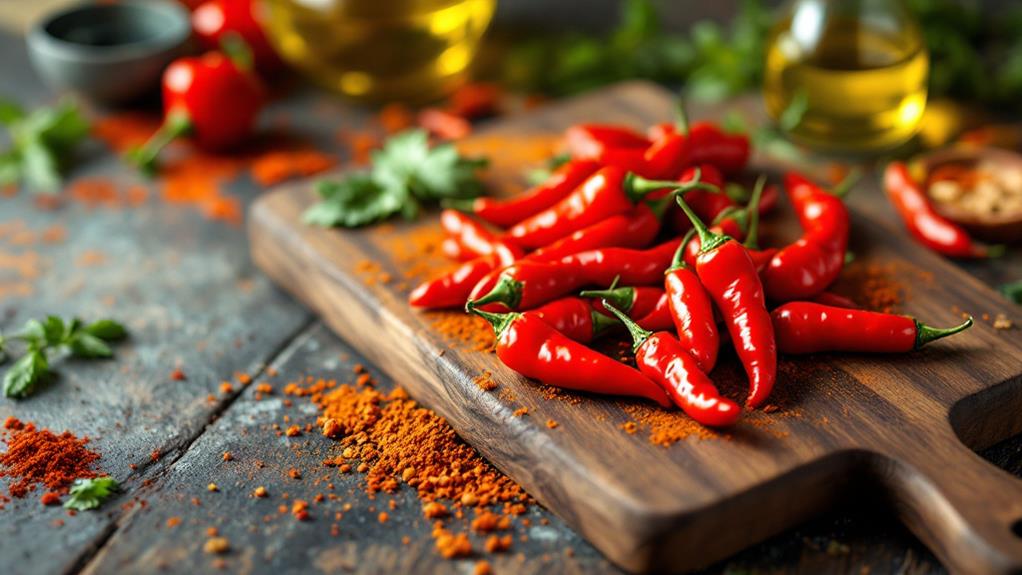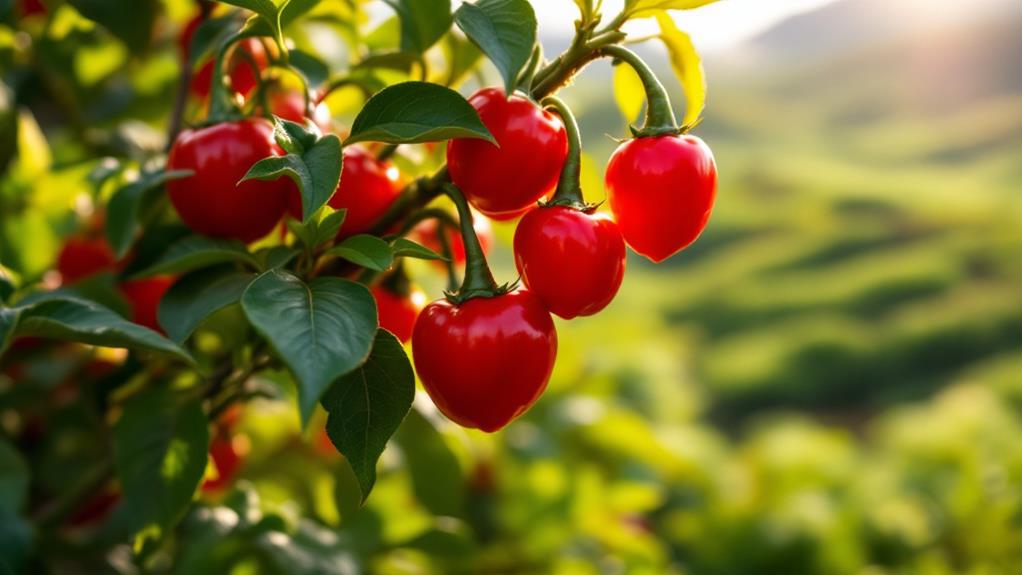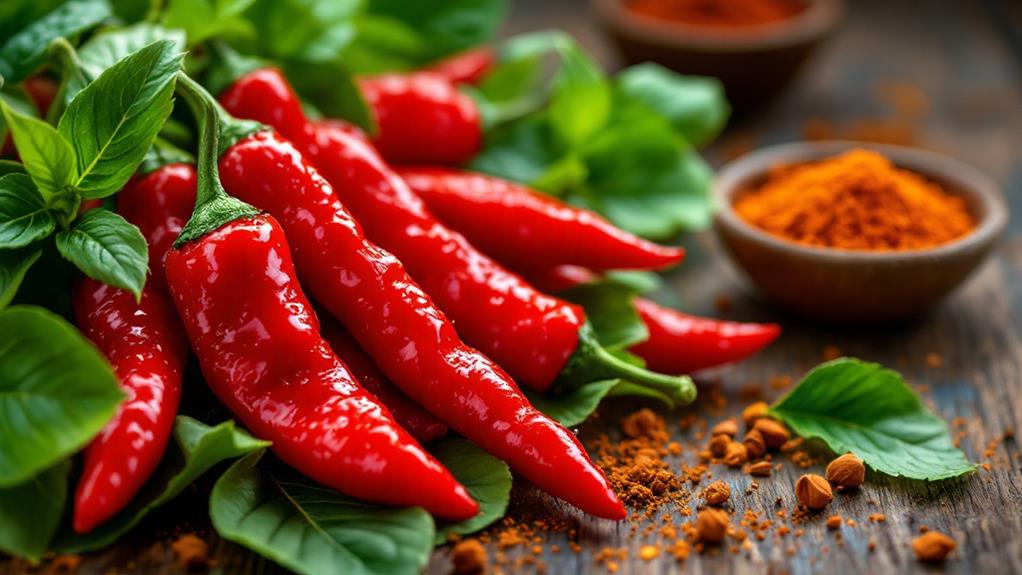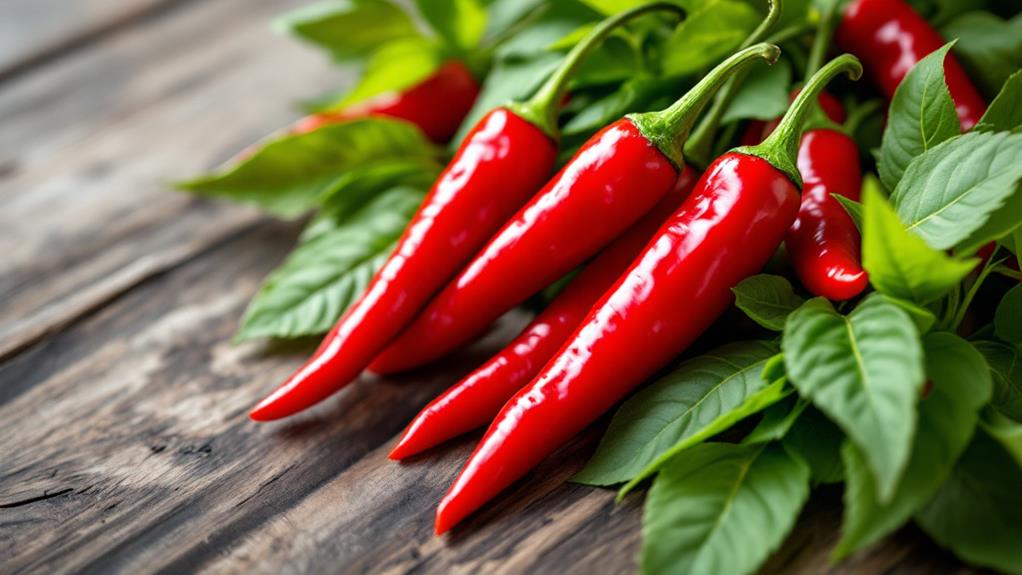The Pasilla Chili Pepper: A Key Ingredient in Mexican Cuisine
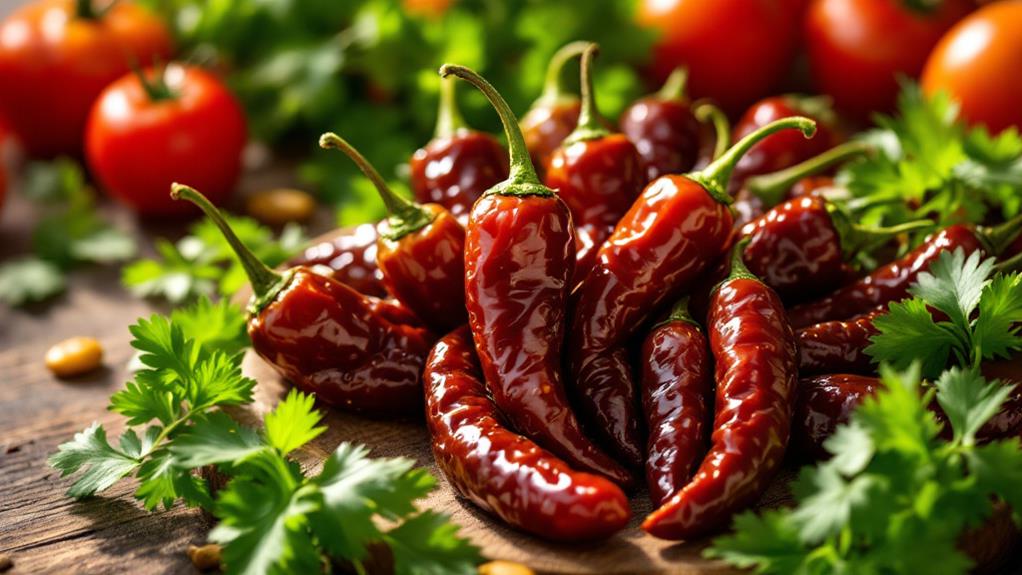
You'll find the Pasilla chili pepper indispensable in Mexican cuisine due to its sweet, tangy flavor and raisin-like aroma. Known as dried chilaca peppers, they measure about 8-10 inches long and boast a mild heat level around 1,000 SHUs. This makes them perfect for enhancing dishes like mole sauces and flavorful salsas without overwhelming heat. Their earthy notes, with hints of raisin and cocoa, add depth to different recipes. Available dried or in powdered form, Pasilla peppers are versatile and easy to incorporate. Discover how this key ingredient can uplift your cooking to more authentic levels.
Understanding Pasilla Peppers
Delving into the world of pasilla peppers, you'll uncover their unique role in Mexican cuisine. These dried chilaca peppers, measuring 8-10 inches long, are a staple in traditional Mexican dishes. Known for their sweet, tangy flavor and raisin-like aroma, pasilla peppers add depth to the recipes they're featured in. Their mild heat level, around 1,000 SHUs, makes them a perfect ingredient for those who want to enjoy flavor without the intense spiciness of hotter chiles.
In Mexican cooking, pasilla peppers are crucial for crafting rich sauces like mole and flavorful salsas. Their dried form allows them to be stored easily and used whenever you want to infuse your dishes with authentic Mexican flavor. You can also find pasilla in powdered form, making it versatile for a variety of culinary applications—from tacos to enchiladas and hearty soups or stews. While substitutes like ancho chiles or guajillo peppers can be used, each brings its own distinct flavor profile, making pasilla peppers irreplaceable for those seeking traditional Mexican taste. Welcome the mild heat and complex flavor of pasilla peppers to enhance your culinary creations.
Flavor and Heat Profile
When you investigate the flavor and heat profile of pasilla peppers, you'll find they offer a sweet, tangy, and slightly smoky taste that makes them a versatile ingredient in many dishes. These peppers have a unique flavor profile, often described as earthy with hints of raisin and cocoa, distinguishing them from similar peppers like the poblano. Their mild heat level, around 1,000 Scoville Heat Units, means they improve dishes without overwhelming the other flavors.
In their dried form, pasilla peppers are a staple in traditional Mexican cuisine. They're especially popular in mole sauces and salsas, where their rich, complex flavor profile adds depth and character. When rehydrated, these peppers release their full potential, making them perfect for soups and stews. Their slightly smoky flavor, combined with their earthy undertones, makes them a must-have in any kitchen that values bold, yet balanced flavors.
Pasilla peppers' versatility is unmatched. Regardless of your aim to add a subtle kick to a dish or seeking to bring out the intricate flavors in traditional Mexican recipes, pasilla peppers are a crucial ingredient that delivers every time.
Culinary Applications
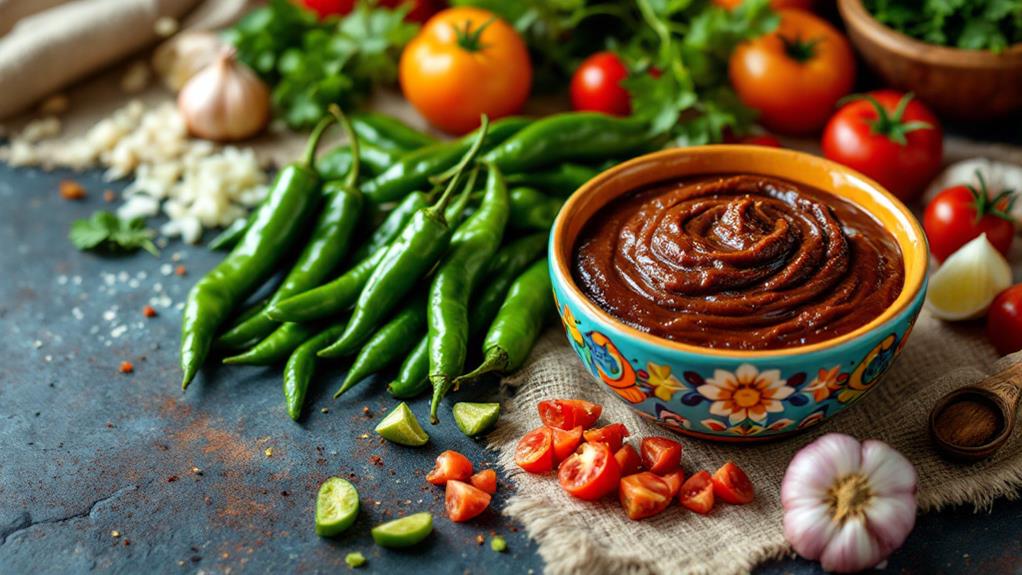
Exploring the culinary applications of pasilla peppers reveals their indispensable role in traditional Mexican cuisine. You'll find that pasilla chiles are a cornerstone in creating authentic mole sauces, thanks to their rich, earthy undertones and medium heat level. This balance makes them ideal for imparting a complex yet approachable flavor, improving your dishes without overpowering them.
When it comes to salsas, pasilla chiles shine with their sweet flavor. A Pasilla Chile Salsa can quickly become a favorite, offering sweet and tangy notes that make your taste buds dance. These chiles can be rehydrated and blended into sauces or soups, providing versatility in your cooking. Their unique flavor profile, reminiscent of raisin and cocoa, pairs perfectly with fresh tomatoes and onions, adding depth to many Mexican staples.
Moreover, you can use pasilla chiles in powdered form as a secret ingredient to boost your salsas. This approach enriches the dish's complexity, delivering a deeper flavor without greatly altering the heat. With their adaptability and distinct taste, pasilla chiles are a must-have in your culinary toolkit, transforming ordinary recipes into extraordinary experiences.
Substitutes for Pasilla
Finding a suitable substitute for pasilla chiles can make all the difference when you're trying to replicate the rich flavors of Mexican cuisine. Ancho chiles, which are dried poblano peppers, are a popular substitute due to their similar flavor profile and heat level, ranging from 1,000 to 2,000 SHUs. They retain the earthy and slightly sweet characteristics that pasilla chiles bring to your dishes.
If you're after a different twist, consider Guajillo peppers. They offer a darker, smokier flavor profile and have a slightly higher heat level, around 2,500 to 5,000 SHUs. Guajillo peppers can add a unique depth to your Mexican recipes.
For those who want sweetness without the spice, raisins can mimic the sweet, tangy flavor of pasilla chiles, although they don't provide any heat. Poblano peppers are another option. Even though they differ in flavor profile, their heat level is similar, making them a viable choice in a pinch.
Don't forget that specialty stores might carry unique alternatives if pasillas are unavailable. These stores can provide a variety of substitutes to keep your Mexican cuisine authentic and flavorful.
Growing Pasilla Chiles
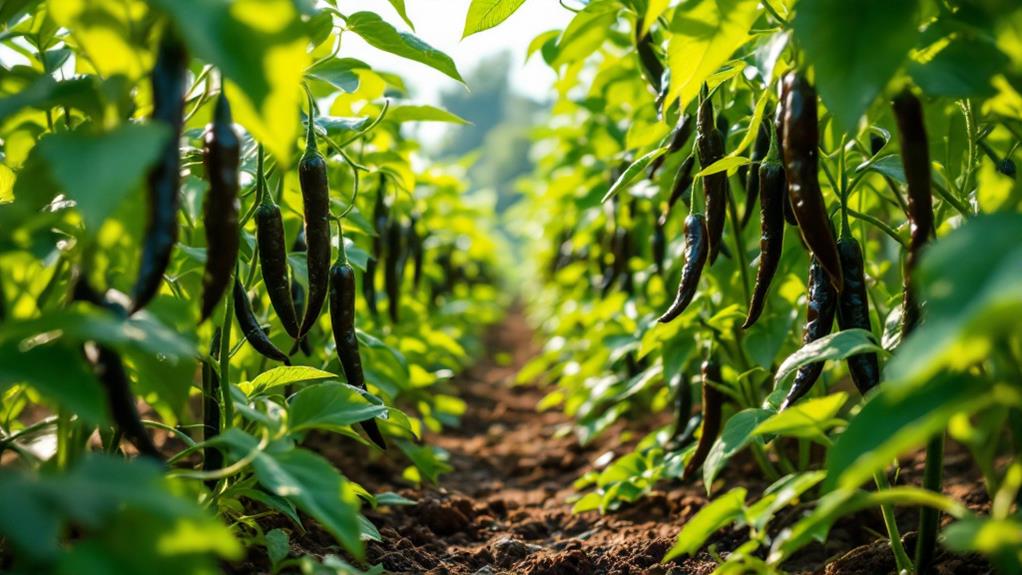
Cultivating pasilla chiles can be a rewarding venture for any gardener, if you're just starting or have years of experience. These peppers, grown from chilaca pepper seeds, thrive when you start them indoors 6-8 weeks before the last frost date. Ensuring ideal growth means giving them full sun and planting them in well-drained soil. Regular watering is vital as it keeps the plants healthy and supports robust fruit development.
Once your seedlings are ready and temperatures stay above 60°F (15°C), you can transplant them outdoors. Pasilla chiles require warmth, and once established, they can grow to an impressive 8-10 inches long. They're fairly easy to cultivate, much like jalapeños or banana peppers, making them an excellent choice for gardeners at any skill level.
When it's time to harvest, look for chiles that have turned dark green or brown. For the best flavor, allow them to ripen fully on the plant before picking. Once harvested, you can dry them to improve their distinctive taste, perfect for different dishes. This pepper variety not only adds unique flavors but also offers a gratifying growing experience.
Purchasing Options
When searching for Pasilla chiles, local specialty stores, especially those focusing on Mexican ingredients, are a great starting point. These stores often stock Dried Pasilla chiles, ensuring you get authentic and high-quality products. However, availability can differ, so it's wise to investigate different local markets to find the best options.
Online purchasing offers a convenient alternative, with platforms like Amazon providing a steady supply of Pasilla chiles. It's essential to buy from trusted suppliers to guarantee quality and authenticity. By checking reviews and supplier ratings, you can make informed decisions and avoid subpar products.
For those interested in expanding their culinary repertoire, consider examining the Pasilla de Oaxaca. This smoked variant brings a unique flavor profile that's gaining popularity in diverse culinary uses. While it might be less common in local markets, online purchasing can make this distinctive chili easily accessible.
Pasilla vs. Pasilla De Oaxaca
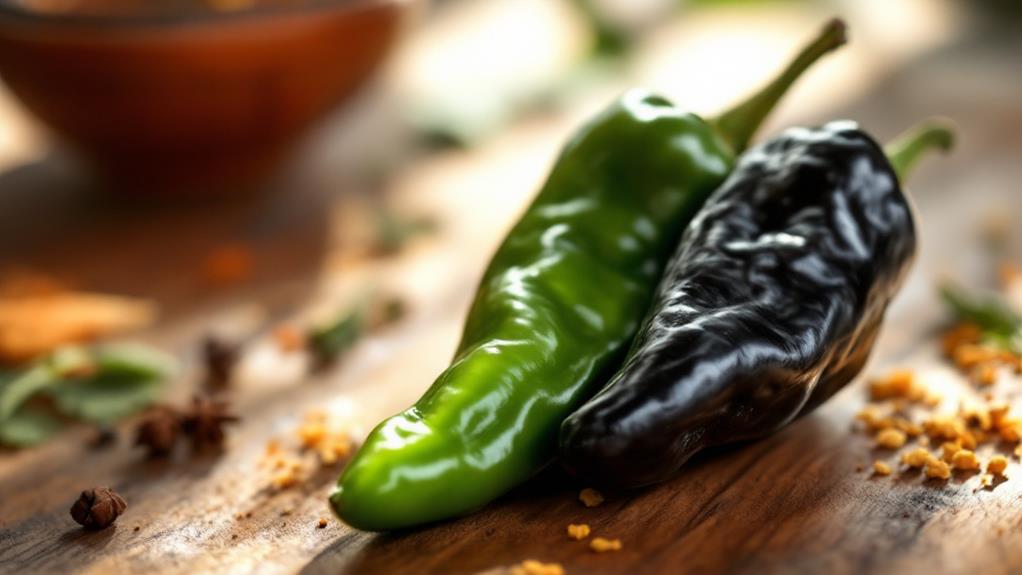
In the domain of Mexican cuisine, understanding the differences between Pasilla and Pasilla de Oaxaca peppers can improve your culinary creations. Pasilla peppers are known for their rich and earthy flavor, making them a staple in classic mole sauces and salsas. They offer a milder heat level, around 1,000 Scoville Heat Units (SHU), which suits dishes requiring subtle heat without overpowering other ingredients.
In contrast, Pasilla de Oaxaca peppers bring a distinctive smoky flavor due to their smoking process. This not only raises their heat level, ranging from 3,000 to 5,000 SHU, but also adds a unique flavor profile that amplifies many modern culinary applications. Their smokiness makes them ideal for recipes that demand a bold and pronounced flavor impact, setting them apart from their non-smoked counterparts.
Both types of Pasilla peppers play integral roles in Mexican cuisine, yet they cater to different culinary needs. When you're crafting dishes that call for a more robust and complex taste, reach for Pasilla de Oaxaca. However, for traditional mole sauces or when you desire a subtler, earthy undertone, the classic Pasilla is your go-to choice. Understanding these differences allows you to choose the perfect pepper for your dish.

